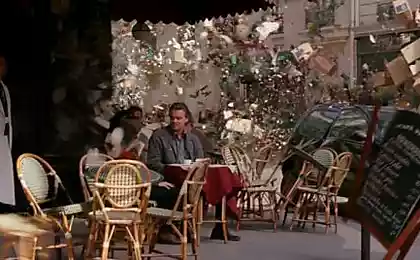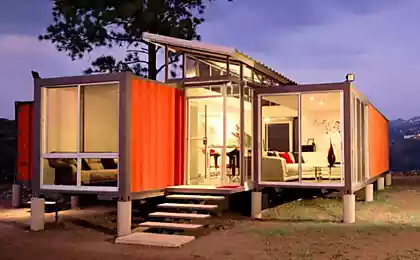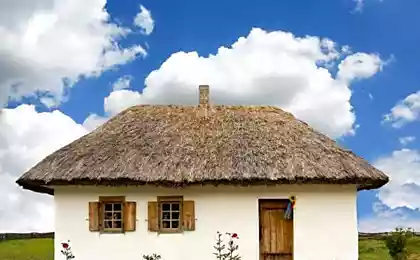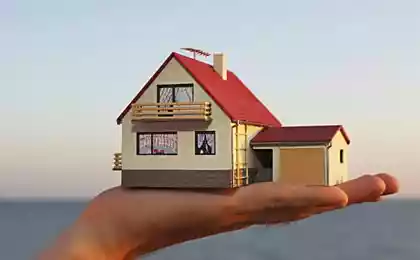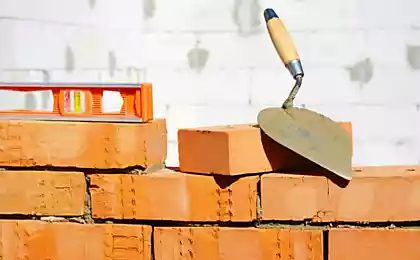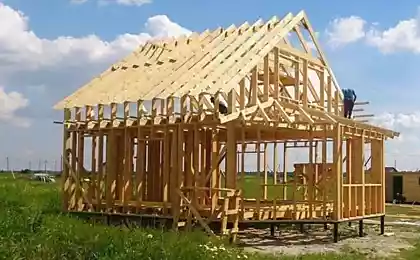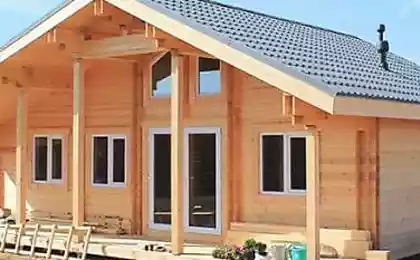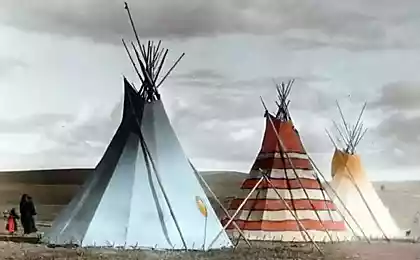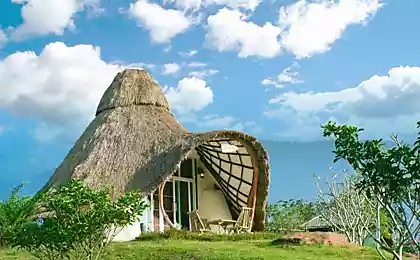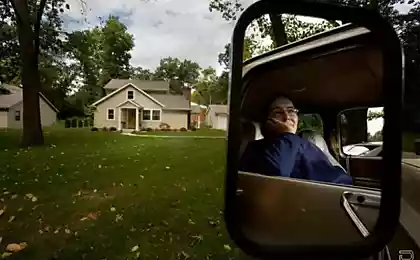662
Down with a mortgage: 15 ancient techniques of building a house with his own hands
There is nothing impossible to build a house with his own hands. Our ancestors did it for thousands of years. You can try it too.
How would your life changed if I did not have to pay for rent or mortgage interest? I bet the stone would drop you off. I would for sure. You are not alone, in fact most people in "civilized" countries don't own their own house and owe the Bank or rent housing. But it was not always so. Henry David Thoreau says is true in her book "Walden":
Savages each family has a roof, not worse than others that satisfy the simplest needs. Birds have nests, foxes have dens, savages, the tepees, and the modern civilized society, I will say without exaggerating that provides shelter not more than half of the families. In large cities, where civilization finally won the the number having shelter is a very small fraction. The rest is annually paid for this outer shell, which became necessary in winter and in summer, the money, which you can buy a village of Indian wigwams, and because of this, live in want all their lives.
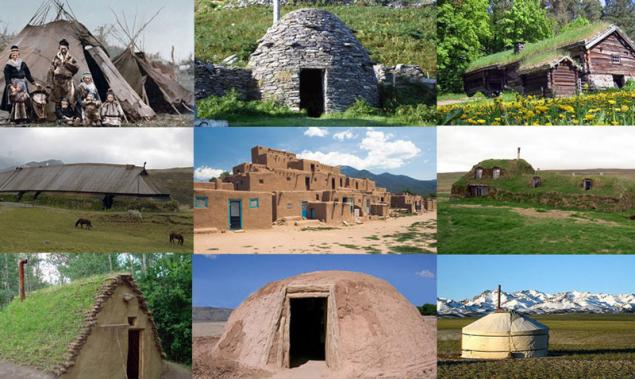
Is this really the best that you can imagine?
Is it really so impossible to imagine a future where human beings, like other animals, are fluent in their housing without any conditions and not have to pay a lot of money all my life just to be protected from the elements? Of course not! It's crazy!
In our list you will find examples of homes that are "wild" people around the world are building their own hands using improvised materials, which mother nature offers for free. No mortgage, no rent. You borrow from this list – it's your business, but I have no doubt that you can learn much from how our ancestors lived in harmony with their surroundings and perfectly adapted to the circumstances, no matter how severe.
Tipi
Teepee is like the tent of the house of American Indians, the plains tribes used. Tipi is constructed of a conical wooden framework, covered with skins of buffaloes, and these tipis were up to 12 feet in height. Like modern tents, tipis can be quickly collapsed or expanded. When the tribe moved from place to place, each family was carrying a stake and skins from his tipi.
Plains Indians often moved from place to place to follow herds of Buffalo. The whole village could for an hour to collect your teepee and be ready to move.
Veja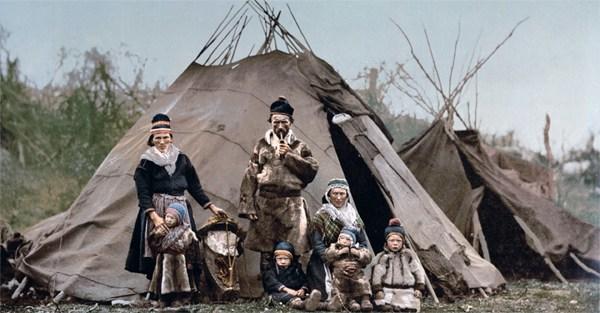
Sami family in front of a large tower, about 1900
Externally, the tower resembles a native American tipi but is less elongated and more stable in a strong wind. This is a temporary shelter used by the Sami tribes, who lived on the treeless plains of Northern Scandinavia, and roamed behind the deer. Tower made from wooden stakes covered with reindeer skins or, more commonly, cloth.
In modern poli replaced the wooden stakes on the aluminum, and heavier fabrics to lighter. Today, many people prefer to heat the tower using the stove instead of the open fire, the advantage of this method is that produced less smoke and less light, which is very dark inside.
Wigwam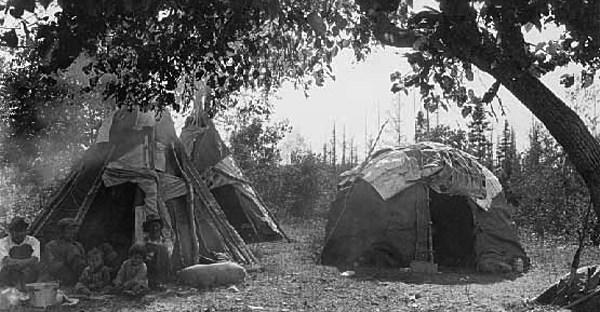
Tepees, sometimes known as "the house of birch bark" is the home of American Indians used by the Algonquin tribes in the forest regions. These homes are small, usually 8-10 feet tall, they are based on a frame of curved wooden stakes that are covered by a variety of available material — grass, bark, twigs, mats, reeds, hides or cloth.
The housing may be in the form of a dome, cone, or rectangle with an arched roof. The curved surfaces serve as perfect shelter in all weather conditions and, although the wigwams stationary, they are small and easy to construct.
In 1674 Gukin in charge of the Affairs of the Indian subjects of Massachusetts colony, wrote: "the Best house is very tightly and carefully lie bark, which is stripped when the tree is filled with juice, and immediately pressed into large chunks until it is green. Houses that are worse than indoor rugs, which are weaved from special reeds; they are also quite warm and do not leak, although not as good as the first... I've seen built, reaching 60 and even 100 feet in length and 30 in width... I often slept in the wigwams, and they were no less warm than the best English houses."
Hogan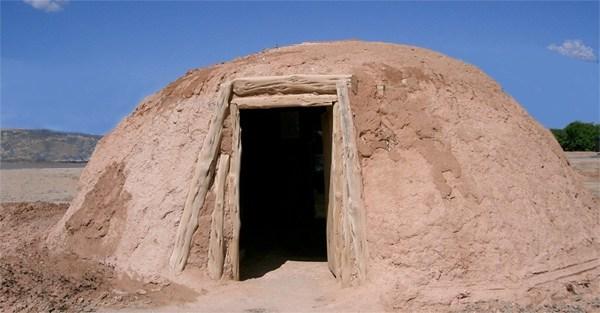
Hogan is the primary traditional dwelling of the Navajo nation. It can be round, conical, faceted or rectangular. It may or may not be inside the rack, the walls of log or stone, and covered it with earth with a variety of options, the roof of bark. It fits.
Old Hogan can be considered the founders of the ideas energy saving home. "Use a thick layer of clay on top of the wooden structure allows this home in the summer to keep cool through natural air circulation and wet the floor. In winter the hearth for a long time keeps the interior warm. This approach is called thermal mass".
In 2001, Hogan began a revival through joint enterprises with the participation of the Navajo nation, Northern Arizona University, U.S. forest service and other private and public partners.
The pit-house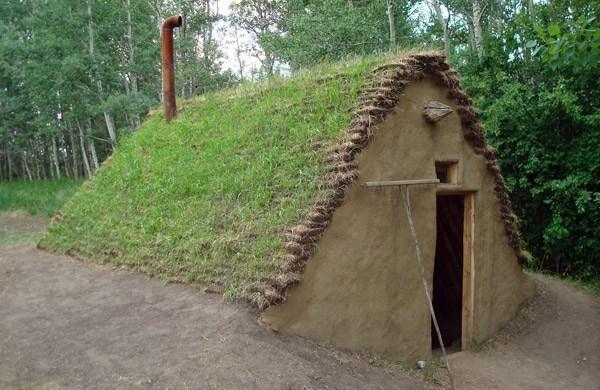
The history of the huts begins 6,000 years ago. Dwellings of this type half represent something of a cross between a house made of sod and log house flooring is usually deepened by 1-1. 5 meters below ground. These homes are in the Carpathians and on the wooded slopes of Eastern Europe, but also found in North America.
Many of the first immigrants from Ukraine to Canada in the late 19th century built their first home in their new homeland. The same house built by Mennonites from the Russian Empire, who settled in the region of Hillsboro in Kansas.
National weekly newspaper, Frank Leslie's Illustrated Newspaper of March 20, 1875, thus describes this building: "...quaint new village in Gnaden, where about twenty farmers built the strangest, but comfortabelness cheap houses that can be seen in the West, using a small amount of logs. Karkana roof built on the ground and covered with grass prairies. These homes serve people and animals being separated from the inside wall of Adobe bricks."
Barbara
Barbara was the traditional housing of the Aleuts, the indigenous people of the Aleutian Islands. Just as the pit-house. Barbara is partially underground, it's easier to resist to a strong wind.
Klochan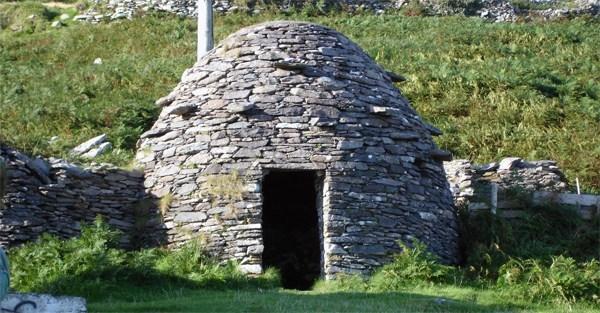
Klochan's built dry stone hut with a projecting roof, which are usually associated with the southwest border of Ireland. Dry construction is a method when the stones are stacked without any binder solution; the fortress of the buildings is achieved due to the pressure of the stones on each other and bonding them together. Klacany usually round in appearance resemble hives, with very thick, up to 1.5 meters, walls. Some klacany not entirely made of stone and are covered with a roof.
Log house
Some of the log buildings were erected in Northern Europe thousands of years ago, and they are basically associated with Scandinavia and Eastern Europe. They are built of logs laid on each other horizontally, with a recess on both ends to increase the grip. Thick trunk provides much better protection than a wooden frame covered with hides, boards or shingles.
Having the necessary tools, the family could have a few days from scratch to build a log house, which potentially could have lasted for centuries. Not far from where I live, is one of the most well-preserved Swedish farms with timber houses built in the 1700s that are still in good condition.
As well as klochan, log cabin gains its strength due to the pressure of the logs on top of each other, and has a tendency to settle slightly over time.
Long house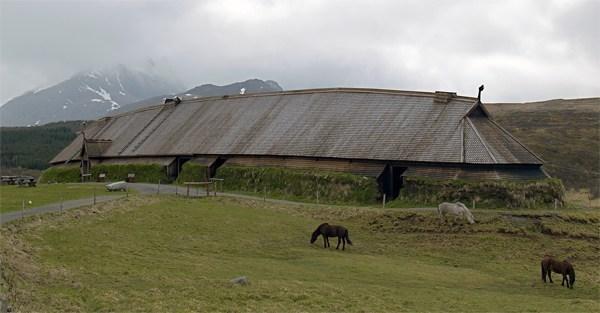
The reconstructed long house at the Viking Museum at Borg on Vestvågøy island in Norway.
Long houses were built everywhere in Europe, Asia and the Americas, but most are associated with the tribes of the Iroquois of North America, as well as ancient Norwegians from Scandinavia, more known as the Vikings.
They are built the same way as wigwams, with a frame of trunks and covered with bark. The main difference is that longhouses are much, much more. They can reach 200 feet in length, 20 in width and 20 in height.
Bamboo house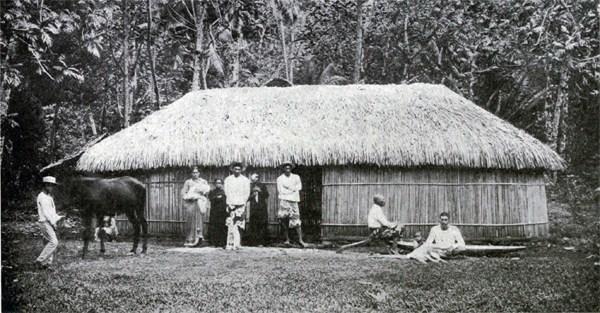
Bamboo house in Tahiti, 1902
This house is important, not design, and excellent building material. Bamboo has a high ratio of strength/weight. It is lightweight, rapidly growing, and is a long-term renewable source of building material.
Bamboo as a building material, traditionally associated with the cultures of South Asia, East Asia and the South Pacific, with some time in Central and South America.
Pueblo
Pueblo built the same tribes of Indians in the southwest USA. This modular, two-storey dwellings made of Adobe (strong bricks of baked clay mixed with straw) or of large stones cemented with Adobe.
The complex of buildings of the Pueblo can accommodate the entire clan, each family lives in his Adobe, as modern houses. These houses can serve dozens of generations in a warm dry climate.
Earthen house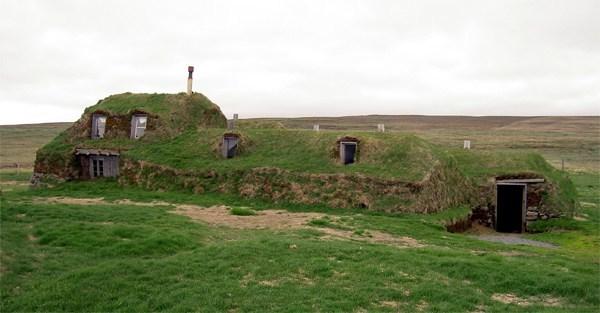
Peat farm house Sanatsal, Iceland
In the old days, met various types of earthen homes around the world, here we can take home the American Indians, for example, Hogan Navajo, earthen den Sioux, pit with a roof of branches in the West Bank and subarctic sod houses in Alaska, Canada and Iceland.
All this semi-underground house, covered the surrounding land with three or four sides and a roof at the top. The main advantage of an earthen house that you're protected from cold and wind with earth, and if you have large Windows on the Sunny side, you can heat the house using the sun.
Needle
Igloo is a snow house used by the Eskimos of Northern Canada. They represent a dome-shaped shelter, constructed of blocks of ice set in a spiral manner and compacted snow.
You will be surprised how it can be warm inside when outside is freezing! "The outside temperature may be-45C, but inside the air is heated from +7C to +16C, only by the heat of human bodies", — Cornell University, 2003.
Yurt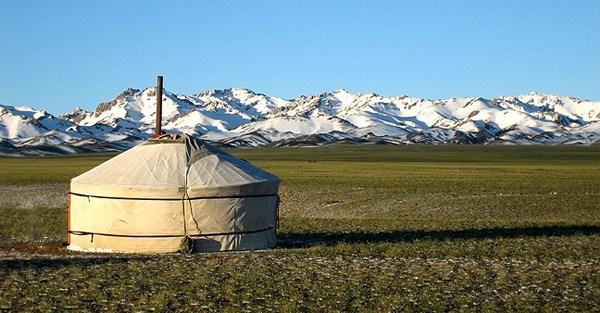
A Yurt is a portable dwelling used by nomads on the slopes of Central Asia for at least 3,000 years. Yes, you read that right, three thousand years.
Traditional yurts consist of a rounded wooden frame, hung with a felt coating full installation takes only 2 hours.
Alipin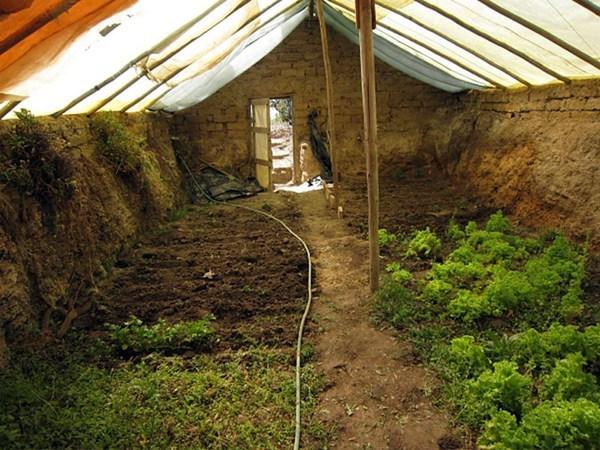
Not as old as others in this list, filipini worth mentioning, because it's a simple but brilliant idea and can be implemented for just $ 300.
Volpini is an underground greenhouse that allows you to grow vegetables all year round. This idea first appeared in Bolivia. Here we use the same earthen floor, as in many ancient houses from our list.
What makes alipine better than conventional greenhouses? First, the positioning area of the plant at 6-8 feet underground, you get the advantage of the constant ground temperature below freezing. Secondly, the surrounding land will retain daytime heat and then gives it back in long cold nights.
What can we learn?Maybe you don't want to move to a tipi in the near future, but still have much to learn from our ancestors.
These ancient houses are largely better than modern because they are adapted to their surroundings. Home of the Arizona desert is very different from the houses from the tundra of Alaska, and the nomadic tribes have different needs than sedentary.
The point is that our ancestors were one with their environment and coexist with nature. These people bylastname earth, while modern man is behaving like the aggressive look that does not know his place in nature.
But maybe the most important thing in these homes that their builders knew when to quit. They clearly realized that the house needed to be protected from rain and have a safe place to sleep, and not waste his life energy to build increasingly large and impressive houses.
And in the end I give the words of Henry David Thoreau:
You can create a house more comfortable and luxurious present but all will be forced to admit that he does not afford. Must we forever strive to get more of all these things, and not try to settle for less? Really respectable citizens will always be of importance to impress upon the young men, and by advice and example, the need to buy before you die, a known amount of unnecessary galoshes and umbrellas or an empty living room empty for guests? Why would our situation not to be as simple as the Arabs or the Indians? published
P. S. And remember, only by changing their consumption — together we change the world! ©
Join us in Facebook , Vkontakte, Odnoklassniki
Source: mixstuff.ru/archives/97495
How would your life changed if I did not have to pay for rent or mortgage interest? I bet the stone would drop you off. I would for sure. You are not alone, in fact most people in "civilized" countries don't own their own house and owe the Bank or rent housing. But it was not always so. Henry David Thoreau says is true in her book "Walden":
Savages each family has a roof, not worse than others that satisfy the simplest needs. Birds have nests, foxes have dens, savages, the tepees, and the modern civilized society, I will say without exaggerating that provides shelter not more than half of the families. In large cities, where civilization finally won the the number having shelter is a very small fraction. The rest is annually paid for this outer shell, which became necessary in winter and in summer, the money, which you can buy a village of Indian wigwams, and because of this, live in want all their lives.

Is this really the best that you can imagine?
Is it really so impossible to imagine a future where human beings, like other animals, are fluent in their housing without any conditions and not have to pay a lot of money all my life just to be protected from the elements? Of course not! It's crazy!
In our list you will find examples of homes that are "wild" people around the world are building their own hands using improvised materials, which mother nature offers for free. No mortgage, no rent. You borrow from this list – it's your business, but I have no doubt that you can learn much from how our ancestors lived in harmony with their surroundings and perfectly adapted to the circumstances, no matter how severe.
Tipi

Teepee is like the tent of the house of American Indians, the plains tribes used. Tipi is constructed of a conical wooden framework, covered with skins of buffaloes, and these tipis were up to 12 feet in height. Like modern tents, tipis can be quickly collapsed or expanded. When the tribe moved from place to place, each family was carrying a stake and skins from his tipi.
Plains Indians often moved from place to place to follow herds of Buffalo. The whole village could for an hour to collect your teepee and be ready to move.
Veja

Sami family in front of a large tower, about 1900
Externally, the tower resembles a native American tipi but is less elongated and more stable in a strong wind. This is a temporary shelter used by the Sami tribes, who lived on the treeless plains of Northern Scandinavia, and roamed behind the deer. Tower made from wooden stakes covered with reindeer skins or, more commonly, cloth.
In modern poli replaced the wooden stakes on the aluminum, and heavier fabrics to lighter. Today, many people prefer to heat the tower using the stove instead of the open fire, the advantage of this method is that produced less smoke and less light, which is very dark inside.
Wigwam

Tepees, sometimes known as "the house of birch bark" is the home of American Indians used by the Algonquin tribes in the forest regions. These homes are small, usually 8-10 feet tall, they are based on a frame of curved wooden stakes that are covered by a variety of available material — grass, bark, twigs, mats, reeds, hides or cloth.
The housing may be in the form of a dome, cone, or rectangle with an arched roof. The curved surfaces serve as perfect shelter in all weather conditions and, although the wigwams stationary, they are small and easy to construct.
In 1674 Gukin in charge of the Affairs of the Indian subjects of Massachusetts colony, wrote: "the Best house is very tightly and carefully lie bark, which is stripped when the tree is filled with juice, and immediately pressed into large chunks until it is green. Houses that are worse than indoor rugs, which are weaved from special reeds; they are also quite warm and do not leak, although not as good as the first... I've seen built, reaching 60 and even 100 feet in length and 30 in width... I often slept in the wigwams, and they were no less warm than the best English houses."
Hogan

Hogan is the primary traditional dwelling of the Navajo nation. It can be round, conical, faceted or rectangular. It may or may not be inside the rack, the walls of log or stone, and covered it with earth with a variety of options, the roof of bark. It fits.
Old Hogan can be considered the founders of the ideas energy saving home. "Use a thick layer of clay on top of the wooden structure allows this home in the summer to keep cool through natural air circulation and wet the floor. In winter the hearth for a long time keeps the interior warm. This approach is called thermal mass".
In 2001, Hogan began a revival through joint enterprises with the participation of the Navajo nation, Northern Arizona University, U.S. forest service and other private and public partners.
The pit-house

The history of the huts begins 6,000 years ago. Dwellings of this type half represent something of a cross between a house made of sod and log house flooring is usually deepened by 1-1. 5 meters below ground. These homes are in the Carpathians and on the wooded slopes of Eastern Europe, but also found in North America.
Many of the first immigrants from Ukraine to Canada in the late 19th century built their first home in their new homeland. The same house built by Mennonites from the Russian Empire, who settled in the region of Hillsboro in Kansas.
National weekly newspaper, Frank Leslie's Illustrated Newspaper of March 20, 1875, thus describes this building: "...quaint new village in Gnaden, where about twenty farmers built the strangest, but comfortabelness cheap houses that can be seen in the West, using a small amount of logs. Karkana roof built on the ground and covered with grass prairies. These homes serve people and animals being separated from the inside wall of Adobe bricks."
Barbara

Barbara was the traditional housing of the Aleuts, the indigenous people of the Aleutian Islands. Just as the pit-house. Barbara is partially underground, it's easier to resist to a strong wind.
Klochan

Klochan's built dry stone hut with a projecting roof, which are usually associated with the southwest border of Ireland. Dry construction is a method when the stones are stacked without any binder solution; the fortress of the buildings is achieved due to the pressure of the stones on each other and bonding them together. Klacany usually round in appearance resemble hives, with very thick, up to 1.5 meters, walls. Some klacany not entirely made of stone and are covered with a roof.
Log house

Some of the log buildings were erected in Northern Europe thousands of years ago, and they are basically associated with Scandinavia and Eastern Europe. They are built of logs laid on each other horizontally, with a recess on both ends to increase the grip. Thick trunk provides much better protection than a wooden frame covered with hides, boards or shingles.
Having the necessary tools, the family could have a few days from scratch to build a log house, which potentially could have lasted for centuries. Not far from where I live, is one of the most well-preserved Swedish farms with timber houses built in the 1700s that are still in good condition.
As well as klochan, log cabin gains its strength due to the pressure of the logs on top of each other, and has a tendency to settle slightly over time.
Long house

The reconstructed long house at the Viking Museum at Borg on Vestvågøy island in Norway.
Long houses were built everywhere in Europe, Asia and the Americas, but most are associated with the tribes of the Iroquois of North America, as well as ancient Norwegians from Scandinavia, more known as the Vikings.
They are built the same way as wigwams, with a frame of trunks and covered with bark. The main difference is that longhouses are much, much more. They can reach 200 feet in length, 20 in width and 20 in height.
Bamboo house

Bamboo house in Tahiti, 1902
This house is important, not design, and excellent building material. Bamboo has a high ratio of strength/weight. It is lightweight, rapidly growing, and is a long-term renewable source of building material.
Bamboo as a building material, traditionally associated with the cultures of South Asia, East Asia and the South Pacific, with some time in Central and South America.
Pueblo

Pueblo built the same tribes of Indians in the southwest USA. This modular, two-storey dwellings made of Adobe (strong bricks of baked clay mixed with straw) or of large stones cemented with Adobe.
The complex of buildings of the Pueblo can accommodate the entire clan, each family lives in his Adobe, as modern houses. These houses can serve dozens of generations in a warm dry climate.
Earthen house

Peat farm house Sanatsal, Iceland
In the old days, met various types of earthen homes around the world, here we can take home the American Indians, for example, Hogan Navajo, earthen den Sioux, pit with a roof of branches in the West Bank and subarctic sod houses in Alaska, Canada and Iceland.
All this semi-underground house, covered the surrounding land with three or four sides and a roof at the top. The main advantage of an earthen house that you're protected from cold and wind with earth, and if you have large Windows on the Sunny side, you can heat the house using the sun.
Needle

Igloo is a snow house used by the Eskimos of Northern Canada. They represent a dome-shaped shelter, constructed of blocks of ice set in a spiral manner and compacted snow.
You will be surprised how it can be warm inside when outside is freezing! "The outside temperature may be-45C, but inside the air is heated from +7C to +16C, only by the heat of human bodies", — Cornell University, 2003.
Yurt

A Yurt is a portable dwelling used by nomads on the slopes of Central Asia for at least 3,000 years. Yes, you read that right, three thousand years.
Traditional yurts consist of a rounded wooden frame, hung with a felt coating full installation takes only 2 hours.
Alipin

Not as old as others in this list, filipini worth mentioning, because it's a simple but brilliant idea and can be implemented for just $ 300.
Volpini is an underground greenhouse that allows you to grow vegetables all year round. This idea first appeared in Bolivia. Here we use the same earthen floor, as in many ancient houses from our list.
What makes alipine better than conventional greenhouses? First, the positioning area of the plant at 6-8 feet underground, you get the advantage of the constant ground temperature below freezing. Secondly, the surrounding land will retain daytime heat and then gives it back in long cold nights.
What can we learn?Maybe you don't want to move to a tipi in the near future, but still have much to learn from our ancestors.
These ancient houses are largely better than modern because they are adapted to their surroundings. Home of the Arizona desert is very different from the houses from the tundra of Alaska, and the nomadic tribes have different needs than sedentary.
The point is that our ancestors were one with their environment and coexist with nature. These people bylastname earth, while modern man is behaving like the aggressive look that does not know his place in nature.
But maybe the most important thing in these homes that their builders knew when to quit. They clearly realized that the house needed to be protected from rain and have a safe place to sleep, and not waste his life energy to build increasingly large and impressive houses.
And in the end I give the words of Henry David Thoreau:
You can create a house more comfortable and luxurious present but all will be forced to admit that he does not afford. Must we forever strive to get more of all these things, and not try to settle for less? Really respectable citizens will always be of importance to impress upon the young men, and by advice and example, the need to buy before you die, a known amount of unnecessary galoshes and umbrellas or an empty living room empty for guests? Why would our situation not to be as simple as the Arabs or the Indians? published
P. S. And remember, only by changing their consumption — together we change the world! ©
Join us in Facebook , Vkontakte, Odnoklassniki
Source: mixstuff.ru/archives/97495



